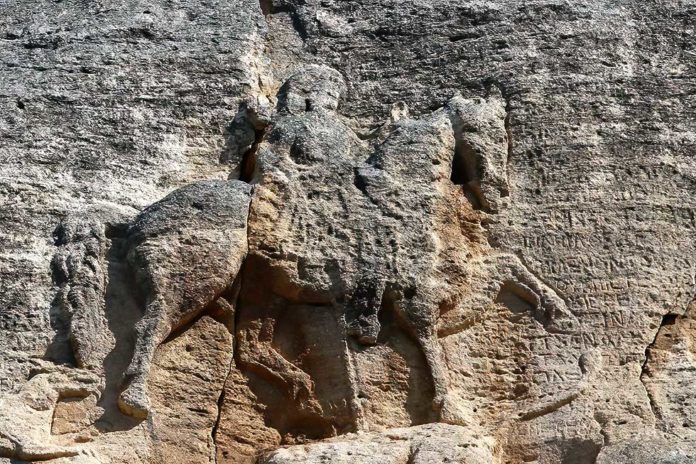The Madara Rider, a unique and enigmatic rock-cut bas-relief in Bulgaria, stands 23 meters above the ground and measures 3.1 meters wide and 2.6 meters high. Located near the village of Madara and approximately 20 km from Shumen, this monument features three figures: a horseman, a dog, and a lion. The life-sized central figure, the horseman, is the highest and is depicted wearing a knee-length garment while riding a high-backed saddle. The composition also includes a reclining lion below the horse’s front legs and a running dog behind the horse, seemingly targeting the lion.
Erosion has made some aspects of the composition unclear and debatable. For instance, the object in the horseman’s left hand could be a wine jug, hunting horn, or horse reins, while the right hand might be throwing a spear at the lion or holding the horse’s bridle. There is also disagreement on whether the rider is cloaked or carries a quiver of arrows and if a spear pierces the lion.
The monument is surrounded by three Greek inscriptions, which reference Bulgarian history from the 8th to the 9th centuries. These inscriptions include information about Khan Tervel and his assistance to the Byzantine Emperor Justinian II. First described in 1872 by Felix Kanitz, the monument’s dating and the identity of the horseman remain subjects of debate. The monument’s surrounding area contains a cave with Thracian artifacts, a Bulgarian pagan sanctuary with a stone inscription of the god Tangra, and a small church, highlighting the area’s long history as a cult center for various religious beliefs.
What is a UNESCO World Heritage Site?
The Madara Rider’s origins have been linked to Thracian culture, the Persian ruler Darius, the ancient Iranian god Mithras, and Bulgarian khans such as Tervel, Krum, or Omurtag. The most widely accepted hypothesis is that the horseman represents Khan Tervel or a generalized image of the rulers of Pliska, symbolizing Bulgarian state power and the self-confidence of its pagan rulers. In 1979, this extraordinary rock relief from the Early Middle Ages was inscribed on the UNESCO list of World Heritage Sites. In 2009, a national survey declared it a global Bulgarian symbol.
Getting there is accessible by car. There are parking spaces and cafeteria shops close to the parking spot for refreshments. The monument is only 200 steps up the hill and is suitable for children’s visits.



